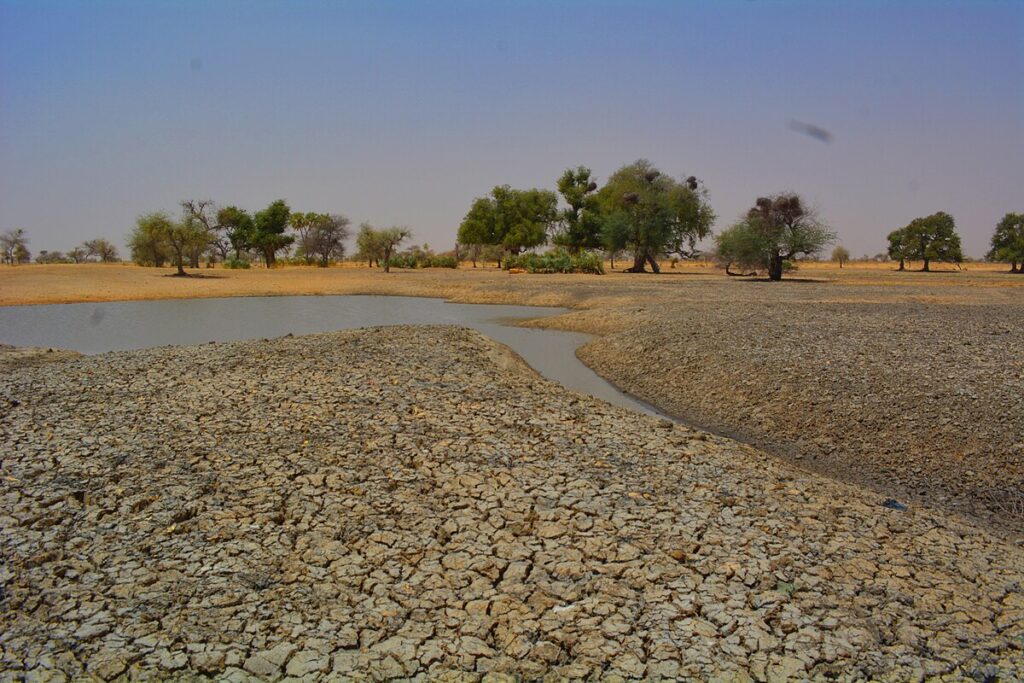Climate Migration and the Law
What is climate migration and why is it on the rise?
Climate migration occurs when people are displaced and uprooted from their homes due to climate-related disasters that are either temporary or permanent, within countries or across borders.
This form of migration is increasing because the world failed to reduce greenhouse gas emissions to halt the rise of global average temperatures. This causes extreme weather events such as droughts, wildfires, floods, and heatwaves.

Inhabitants of northern Nigeria are unable to grow food due to drought. Image courtesy of Hajjare is licensed under CC BY-SA 4.0.
Who is impacted the hardest?
Three regions – Sub-Saharan Africa, South Asia, and Latin America – will be most impacted by climate migration. These areas represent 55% of the developing world’s population. By 2050, an estimated 143 million people from these regions could be forced to move to escape the impacts of climate change.
The United Nations estimates that women make up 80% of climate migrants.
International Legal Responses
Although climate migrants are often referred to as “climate refugees,” most do not meet the legal definition of ‘refugee.’ The 1951 UN Refugee Convention defines a refugee as: “someone who is unable or unwilling to return to their country of origin owing to a well-founded fear of being persecuted.”
Climate migrants have not fled from violence or persecution, and often they stay within their national borders. Therefore, climate migrants do not qualify for refugee status and are deprived of many important protections afforded to refugees.
The only binding treaty that offers protections to climate migrants is the 1969 Organisation of African Unity (OAU) Convention, which governs refugee protection in Africa. However, due to its regional scope and failure to expressly recognize climate refugee status, the 1969 OAU Convention does not provide broad international protections for climate refugees.
More recent documents including the Global Compact on Safe, Orderly and Regular Migration (GCM) and the New York Declaration for Refugees and Migrants provide governments with a framework to address climate migration. While the GCM acknowledges climate change as a factor in driving migration, it does not outline distinct legal protections for those affected.
Looking Forward
Climate migrants require additional legal protection. Possibilities for reform include revision of the 1951 Refugee Convention to incorporate language on climate migration, or creation of a new convention or treaty to define characteristics of climate migrants and provide for global protections.
Global debates over climate migrant classification and how to address climate change make these reforms unlikely to occur. There is additional concern that political opportunists, who view the existing refugee convention as too generous, would use its renegotiation to weaken current refugee protections.
Increasing efforts to meet the UN Sustainable Development Goals and appointing a UN special rapporteur to guide climate talks would help mitigate the scope and impact of climate migration.
This page was authored for World Without Genocide by Joanna Michalopoulos, Law and Human Rights Intern.
Updated: September 2023.
Read about climate change legislative developments here.
Learn more about the link between climate change and conflict here.
Find out how your city will be affected by climate change here.
Take action here.
Find resources including scholarly articles, fiction and non-fiction books, documentaries, and other resources about climate change here.
References
Bergeron, Tyler. “No Refuge for ‘Climate Refugees’ in International Law.” Lewis and Clark Law School, 2022, https://www.lclark.edu/live/blogs/200-no-refuge-for-climate-refugees-in-international#:~:text=Current%20Protections%20for%20International%20Climate%20Refugees&text=Aside%20from%20the%201951%20Convention,refugees%20in%20the%201951%20Convention.
Council on Foreign Relations, 19, December 2022, https://www.cfr.org/in-brief/climate-change-fueling-migration-do-climate-migrants-have-legal-protections
Rigaud, Kanta Kumari et al. Groundswell: Preparing for Internal Climate Migration. World Bank, Washington, DC, 2018.
Greenfield, Nicole. “Climate Migration and Equity.” NRDC, 9 May 2022, https://www.nrdc.org/stories/climate-migration-equity
Prange, Mia. “Climate Change is Fueling Migration. Do Climate Migrants Have Legal Protections?” United Nations. “Climate change exacerbates violence against women and girls.” United Nations, 12 July 2022, https://www.ohchr.org/en/stories/2022/07/climate-change-exacerbates-violence-against-women-and-girls
Spyridoula, Katsoni. The Future of “Climate Refugees” in International Law.” Volkerrechtsblog, 05 June 2021, https://voelkerrechtsblog.org/the-future-of-climate-refugees-in-international-law/


